Religious Idols
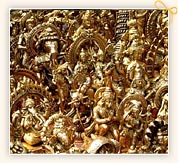 Idol-worship seems to have set its roots in Hinduism much
before Vedic era began. The Indian idol is considered as a substitute or
symbol. The statues of God and Goddess are precious for the devotees as
they bear the mark of his Lord. The devotee feels the presence of Lord in
the image and it represents holiness and eternal blessings. Made of
various materials, idols are worshiped everywhere - in home, in temples
and any other religious place.
Idol-worship seems to have set its roots in Hinduism much
before Vedic era began. The Indian idol is considered as a substitute or
symbol. The statues of God and Goddess are precious for the devotees as
they bear the mark of his Lord. The devotee feels the presence of Lord in
the image and it represents holiness and eternal blessings. Made of
various materials, idols are worshiped everywhere - in home, in temples
and any other religious place.Style of Idols
- Maratha style : The style dates back to 17th or 18th century and in this style of idol making, blocks of stones are converted into idols.
- Hoysala style : The idols crafted out of this style usually highlight sharp features, sophisticated and ornamented artistry and a distinct style.
- Tanjore style : Idols crafted out of this represent the traditional Tanjore sculptures.
- Jaipur style : In this style, white Makrana marble is carted into roughly-shaped blocks, which is finally shaped into figures of Gods and Goddesses.
-
Hindu God Idols
Hinduism is known for the variety of gods and goddesses, who are worshipped in various forms. Hinduism is believed to be "apauruseya", that is of impersonal origin and so are the Gods of Hinduism. The Hindu gods and goddesses are eternal and though the deities appear to be different and independent, they are really facets of the same Supreme God.
The main Hindu Gods as is accepted today can be broadly classified as Saiva Gods (Siva, his consort, his sons, his other forms), Vaishnava Gods (Vishnu, his consort, his various avatharams).
In Hinduism, many Gods are worshiped and some of them areAshwini Kumaras
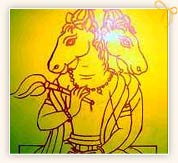 Ashwini Kumaras are the twin gods of Hindu mythology.
First physicians/healers of heaven and earth. The word 'ashwini' means
horsewoman in Sanskrit, and the word 'kumara' denotes eternal youth.
Sanjna (Lord Surya's wife) was wandering around the Universe in the
form of a mare in the absence of her husband. Lord Surya saw through
her deception and assumed the form of a horse. Ashwini Kumaras are a
result of this union.
Ashwini Kumaras are the twin gods of Hindu mythology.
First physicians/healers of heaven and earth. The word 'ashwini' means
horsewoman in Sanskrit, and the word 'kumara' denotes eternal youth.
Sanjna (Lord Surya's wife) was wandering around the Universe in the
form of a mare in the absence of her husband. Lord Surya saw through
her deception and assumed the form of a horse. Ashwini Kumaras are a
result of this union.
Ashwini Kumaras are associated with the lunar constellation Ashwini, which is related to healing and eternal youth. They are depicted as twins with the head of a horse, and a human body. They are regarded as the embodiments of knowledge and speed. Ashwini Kumaras also represent the fleeting moments between night and dawn (speed), and herald dawn (knowledge).Lord Agni
Lord Agni is the also known as Agni dev. He is the young, immortal Lord of fire, and holds the second position in Hindu mythology after Indra. He was born from a lotus created by Brahma (the Creator in Hindu mythology). The word 'agni' means fire in Sanskrit. This word also has its roots in the Latin word 'ignis', from which the English word 'ignite' is derived.
Hindu mythology and Vedic scriptures describe Lord Agni as red hued, having three legs, seven tongues, seven hands, and two faces. The two faces are suggestive of his beneficient and destructive qualities. Seven rays of light emanate from his person. Lord Agni rides a ram, and is the creator of a fire weapon called 'agneyastra'. Lord Agni is the guardian of the Southeast direction. The three mukhi (three-faced) rudraksh bead is the symbol of Lord Agni. Like fire that burns all impurities, the wearer will be purged of all sins and attain purity of thought and deed.Lord Ayyappa
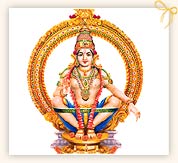 Lord Ayyappa is a celibate Hindu god. Lord Ayyappa is
said to have been born out of the union of Lord Shiva and Lord Vishnu
(in His female form 'Mohini'). Hence, he is known by other names like
Hariharaputra, Hariharasuthan, Ayyappan, Manikanta and so on. Lord
Ayyappa is known for his benevolence. As an infant, Lord Ayyappa lay
on the banks of the river Pampa. King Rajashekhara, ruler of Pandalam
heard his wails. Since the king had no children, he brought Lord
Ayyappa to his palace and adopted him.
Lord Ayyappa is a celibate Hindu god. Lord Ayyappa is
said to have been born out of the union of Lord Shiva and Lord Vishnu
(in His female form 'Mohini'). Hence, he is known by other names like
Hariharaputra, Hariharasuthan, Ayyappan, Manikanta and so on. Lord
Ayyappa is known for his benevolence. As an infant, Lord Ayyappa lay
on the banks of the river Pampa. King Rajashekhara, ruler of Pandalam
heard his wails. Since the king had no children, he brought Lord
Ayyappa to his palace and adopted him.
As a child, Lord Ayyappa imparted to the king, the principles of attaining Moksha (salvation). He also instructed the king to construct a temple atop the Sabarimala hill. After the temple was constructed, Lord Ayyappa entered the sanctum sanctorum and never returned. He is said to have merged with the Supreme Power. Lord Ayyappa is worshiped across India, and is the presiding deity of the Sabarimala temple in Kerala (India).Lord Balaram
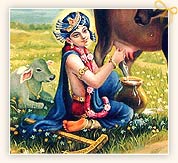 Lord Balarama is the son of Devaki and Vasudeva. He
incarnated as the elder brother of Lord Krishna. He is believed to
be the incarnation of Sheshnaga, or the serpent on whom Lord Vishnu
rests. Lord Balarama is described as fair, and wearing blue
garments. His neck is adorned with a garland of forest flowers, and
he carries a plough in his hand.
Lord Balarama is the son of Devaki and Vasudeva. He
incarnated as the elder brother of Lord Krishna. He is believed to
be the incarnation of Sheshnaga, or the serpent on whom Lord Vishnu
rests. Lord Balarama is described as fair, and wearing blue
garments. His neck is adorned with a garland of forest flowers, and
he carries a plough in his hand.
Lord Balarama is also considered to be the ninth incarnation (avatar) of Lord Vishnu. He is also known by the name Baladeva, and is the best friend of Lord Krishna. With Lord Jagannath (another form of Lord Krishna), he incarnated as Balabhadra. He is known for his immense strength. Lord Balarama denotes eternal truth and knowledge. Lord Balarama is also worshiped as 'adiguru' or Supreme Teacher.Lord Bhairav
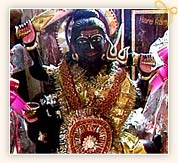 Lord Shiva incarnated as Lord Bhairav. "Bhairava"
means terrifying, and Lord Shiva in his fearsome aspect is called
Lord Bhairav. He is pictured with blue or black skin, bulging eyes,
and a mustache. He has a dog as his divine vehicle. He is usually
associated with Tantra. Worshiping Lord Bhairav bestows victory over
enemies, materialistic comforts, and success. The origin of Lord
Bhairav can be traced to the legend of Shiva and Sati.
Lord Shiva incarnated as Lord Bhairav. "Bhairava"
means terrifying, and Lord Shiva in his fearsome aspect is called
Lord Bhairav. He is pictured with blue or black skin, bulging eyes,
and a mustache. He has a dog as his divine vehicle. He is usually
associated with Tantra. Worshiping Lord Bhairav bestows victory over
enemies, materialistic comforts, and success. The origin of Lord
Bhairav can be traced to the legend of Shiva and Sati.
Sati's (Lord Shiva's wife's) father Daksha slighted Shiva by not inviting him to a yajna which was attended by other gods. Lord Shiva was enraged when Sati immolated herself in the sacrificial fire. He killed Daksha, and carried Sati's lifeless body around the Universe performing the 'tandava' dance. Lord Vishnu realized that the end of the world was near. He cut Sati's body with his Sudarsana chakra, and the pieces fell in various parts in and around India. These places came to be famous as shakti peethas or places of worship of the Mother goddess. Since then, Lord Shiva protects these temples in the form of Lord Bhairav.Lord Brahma
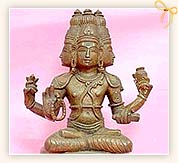 The creation of Lord Brahma is stated differently
in different legends. According to Puranas, he is self-born (without
mother) in the lotus which grows from the navel of Vishnu at the
beginning of the Universe. According to another legend, Lord Brahma
created himself by first creating water.
The creation of Lord Brahma is stated differently
in different legends. According to Puranas, he is self-born (without
mother) in the lotus which grows from the navel of Vishnu at the
beginning of the Universe. According to another legend, Lord Brahma
created himself by first creating water.
Lord Brahma is the is the Hindu God of Creation, and is the first of member of the Hindu Trinity or Trimurti, the others being Vishnu and Shiva. He created the Gods and placed them in different worlds : Agni on earth, Vayu in the atmosphere and Surya in the sky.
Lord Brahma is traditionally depicted with four heads, four faces and four arms. Each head describes one of the four Vedas. He is usually depicted with a white beard, to match the near eternal nature of his existence. One of his hands is depicted holding a scepter in the form of a spoon, which is associated with the pouring of holy Ghee or oil into a sacrificial pyre. This symbolises that Brahma is the Lord of sacrifices. The second hand holds a Kamandalu (a water-pot), which signifies that it is the initial, all-encompassing ether in which the first element of creation evolved. The Lord also holds a string of rosary beads that he uses to keep track of the Universe's time. Lord Brahma is represented holding the Vedas, and sometimes, a lotus flower in his fourth hand.
Lord Brahma's vehicle is a swan (Hans) which is known for its judgment between good and bad. Lord Brahma's consort is Goddess Saraswati, the Goddess of knowledge and art.
Lord Buddha
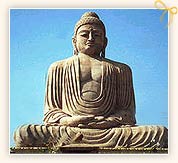 Lord Buddha is considered the ninth avatar
(incarnation) of Lord Vishnu. He is the founder of Buddhism.
"Buddha" means 'enlightened one'. Lord Buddha was born in 560 B.C.
(approximately). The place of his birth was Lumbini, near the city
of Kapilavastu (now in Nepal). He was born to the royal couple
Suddhodana and Maya Devi. He was named Siddhartha. He is also known
as Gautama Buddha.
Lord Buddha is considered the ninth avatar
(incarnation) of Lord Vishnu. He is the founder of Buddhism.
"Buddha" means 'enlightened one'. Lord Buddha was born in 560 B.C.
(approximately). The place of his birth was Lumbini, near the city
of Kapilavastu (now in Nepal). He was born to the royal couple
Suddhodana and Maya Devi. He was named Siddhartha. He is also known
as Gautama Buddha.
Lord Buddha realized very early in life that life is an illusion (Maya). He renounced the world when he was twenty eight years old even though he was married. He taught the path of Nirvana (liberation) to his father, wife and son before he left his home forever. His teachings include ahimsa (non-violence) and dharma (right conduct). He left the world in 480 B.C. at the age of eighty. The Mahabodhi Temple (Bodh Gaya, India) was built to honor the place (and the tree) where Lord Buddha attained enlightenment.Lord Budh
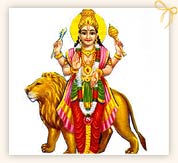 Lord Budh is associated with the planet Mercury.
Lord Budh is also known as Budha, or Grahapati (lord of the
planets). According to Vedic myth, Lord Chandra (the Moon) was
overcome with lust on seeing Brihaspati's (Jupiter's) wife Tara.
Lord Chandra abducted Tara, and Lord Budha (Mercury) is the result
of this unoin. Thus, it is believed that the intellect (Mercury)
is born out of the mind (Moon).
Lord Budh is associated with the planet Mercury.
Lord Budh is also known as Budha, or Grahapati (lord of the
planets). According to Vedic myth, Lord Chandra (the Moon) was
overcome with lust on seeing Brihaspati's (Jupiter's) wife Tara.
Lord Chandra abducted Tara, and Lord Budha (Mercury) is the result
of this unoin. Thus, it is believed that the intellect (Mercury)
is born out of the mind (Moon).
Lord Budha is depicted as having four hands, wearing yellow clothes and ornaments made of yellow flowers. Mercury is also known as 'grahapati' or lord of the planets. Lord Budha blesses his devotees with wisdom and wealth, and he also removes all evil thoughts. He is the guardian of the north direction. Emerald is his gem, and Wednesday is his ruling day. He rules the zodiac signs Gemini and Virgo.Lord Chandra
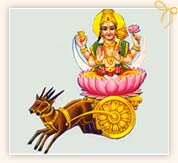 Lord Chandra is also known as Moon. He is also
known as the lord of the stars. "Chandra" in Sanskrit means
'bright and shining'. He is also known as Soma, named after the
intoxicating drink of the gods. Lord Chandra occupies the second
position amongst the nine planets or Navagrahas. He adorns Lord
Shiva's head.
Lord Chandra is also known as Moon. He is also
known as the lord of the stars. "Chandra" in Sanskrit means
'bright and shining'. He is also known as Soma, named after the
intoxicating drink of the gods. Lord Chandra occupies the second
position amongst the nine planets or Navagrahas. He adorns Lord
Shiva's head.
Lord Chandra rules the zodiac sign Cancer. He also rules over the tides of the sea. His gems are moonstone and pearl. Lord Chandra's ruling day is Monday. He is the guardian of the northwest direction. His metal is silver. Worshiping Lord Chandra is said to provide relief from sorrows and mental afflictions.Lord Dattatreya
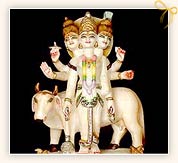 According to Hindu mythology, Lord Dattatreya is
believed to be the combined avatar (incarnation) of the Hindu
trinity (Brahma, Vishnu and Shiva). Sage Atri prayed to the Hindu
trinity, and when they were pleased with his penance, they
appeared before him and offered to grant him a boon. Sage Atri
asked for an offspring that would have their benevolent qualities.
Thus, Lord Dattatreya was born.
According to Hindu mythology, Lord Dattatreya is
believed to be the combined avatar (incarnation) of the Hindu
trinity (Brahma, Vishnu and Shiva). Sage Atri prayed to the Hindu
trinity, and when they were pleased with his penance, they
appeared before him and offered to grant him a boon. Sage Atri
asked for an offspring that would have their benevolent qualities.
Thus, Lord Dattatreya was born.
Lord Dattatreya is depicted as having three heads, symbolizing the past, present, and future. His three heads also symbolize the three states of consciousness. He is pictured with four dogs around him, which represent the four Vedas and his mastery over them. Lord Dattatreya is considered the teacher of all gods. He dispels all evil influences.Lord Dhanvantri
Lord Dhanvantri is the discoverer of Ayurveda, and is considered the physician of the gods (like the Ashwini Kumaras). According to Hindu mythology, Lord Dhanvantri appeared while the primeval ocean was being churned. He brought with him the knowledge of long life, health, and medicine. When the primeval ocean was being churned for the Nectar of Immortality, 14 gems were produced, and Lord Dhanvantari is considered one amongst them.
Lord Dhanvantari destroys negativity and blesses his devotees with good health. He is also known by the name Sudhapani, since he appeared with the pot of Nectar in his hands. The day of his appearance is celebrated on the thirteenth day or 'trayodasi' when the moon is in its waxing phase. This day is celebrated every year, a few days before Diwali/Deepavali (the festival of lights).Lord Ganesha
In Hinduism, Lord Ganesha is one of the most well-known and venerated god. Ganesha is the son of Lord Shiva and Goddess Parvati with an elephantine countenance with a curved trunk, big ears and a plump belly. 'Ga' symbolizes Buddhi (intellect) and 'Na' symbolizes Vidnyana (wisdom). Therefore, Ganesha is considered the master of intellect and wisdom. Lord Ganesha rides on or is attended by a mouse. He is most commonly represented sitting down, with one leg raised in the air and bent over the other.
He is regarded as the Lord of success, wisdom prosperity and the destroyer of evils and obstacles. Lord Ganesha is invoked at the beginning of any journey, wedding ceremony and enterprise.
The consort of Ganesha is Riddhi (material abundance) and Siddhi (intellectual and spiritual power).
Ganesha idols are crafted out of various materials including :- Stone
- Wood
- Ashtadhatu
- Brass
- Sphatik/Crystal
- Parad/Mercury
The height and weight of Ganesha idols vary depending on the materials used for making them.
There are various styles of Ganesha idols including :
Deepak Ganesha Idol : In this type of idol, Lord Ganesha is represented as wearing a crown. The base of the idol has five cups or diyas where oil lamps can be lit. These idols are mainly made of brass and look very beautiful with an antique finish.
Panchmukha Ganesha Idol : Panchmukhi means having five faces. In some ancient scriptures, Ganesha is depicted as having five heads. This type of Ganesha idol is very popular in South India and is mainly worshipped for good luck and prosperity. These idols are also carved in brass.
Jhoola Lakshmi Ganesha Idol : This type of idol is mainly crafted in brass, sphatik and parad and depicts Lord Ganesha and Goddess Lakshmi together in a jhoola (swing). The idol of Lakshmi Ganesha is worshipped on Diwali nights. Lakshmi is regarded as the Goddess of wealth and Ganesha is regarded as the Lord of prosperity and good luck. The idol of Lakshmi Ganesha looks antique and also serves as an excellent gift item on Diwali and other festivals.Lord Garuda
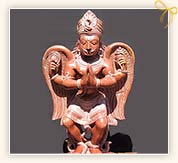 In Hindu mythology, Lord Garuda is one of
the principal animal deities. He is the son of the sage
Kashyap and Vinita (Daksha's daughter). He is also known as
the King of Birds. Lord Garuda is the divine carrier/vehicle
of Lord Vishnu. His speed of flight mocks the wind. Lord
Garuda is also considered the destroyer of all obstacles.
In Hindu mythology, Lord Garuda is one of
the principal animal deities. He is the son of the sage
Kashyap and Vinita (Daksha's daughter). He is also known as
the King of Birds. Lord Garuda is the divine carrier/vehicle
of Lord Vishnu. His speed of flight mocks the wind. Lord
Garuda is also considered the destroyer of all obstacles.
Lord Garuda is pictured as having a head and wings of an eagle while his body belongs to that of man. He has a white head, red wings, and a golden body. He was born with extreme hatred for evil, and it is believed that he wanders around the Universe devouring evil-doers. His hatred for snakes is also well known. Lord Garuda is always worshiped along with Lord Vishnu, and never as a separate deity.Lord Guru
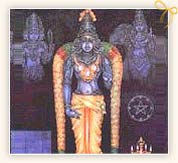 Lord Guru is the planet of Jupiter. He is
also known as Brihaspati and Devagura. Lord Guru is the
preceptor of Indra (king of the gods), and is the most
auspicious of planets. According to the Shiva Purana, Lord
Guru is the son of sage Angirasa and Surupa. He has three
wives, namely Shuba, Tara, and Mamata. The color of Lord
Guru is yellow, and he also wears yellow robes.
Lord Guru is the planet of Jupiter. He is
also known as Brihaspati and Devagura. Lord Guru is the
preceptor of Indra (king of the gods), and is the most
auspicious of planets. According to the Shiva Purana, Lord
Guru is the son of sage Angirasa and Surupa. He has three
wives, namely Shuba, Tara, and Mamata. The color of Lord
Guru is yellow, and he also wears yellow robes.
Lord Guru blesses his devotees with strength, knowledge, longevity, and progeny. He cures ailments of the stomach and wards off sins. Lord Guru is also benevolent, and a dispenser of justice. His metal is gold, and his gem is yellow topaz/yellow sapphire. His day is Thursday. Lord Guru is the guardian of the north-east direction.Lord Hanuman
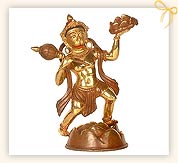 Lord Hanuman is one of the incarnations of
Lord Shiva. He is depicted as a monkey and is known for his
bravery, heroic deeds and eternal devotee of Lord Rama. The
idol of Lord Hanuman represents him holding a Gada (mace),
which reflects courage and bravery along with a picture of
Lord Rama tattooed on his chest, which symbolizes his
eternal devotion.
Lord Hanuman is one of the incarnations of
Lord Shiva. He is depicted as a monkey and is known for his
bravery, heroic deeds and eternal devotee of Lord Rama. The
idol of Lord Hanuman represents him holding a Gada (mace),
which reflects courage and bravery along with a picture of
Lord Rama tattooed on his chest, which symbolizes his
eternal devotion.
Lord Hanuman has many names like "Mahaveera" (the great hero ), "Pavan-suta" (Son of Air), "Bajarangbali" (one with unlimited power). The worshiper of Lord Hanuman is always blessed with pure and unselfish devotion.
Hanuman Idol is the provider of hope, knowledge, fearlessness, intellect and is a symbol of endless devotion. He is the greatest devotee of Lord Rama and has been given a boon to be worshipped through all the "Yugas" (Eras) of Hindu time scale.
The idol of Lord Hanuman is usually made of :- Stone
- Brass
- Parad
The idols of Lord Hanuman come in different height, weight and base length. These parameters depend on the type of material used for making the idol.
Lord Hayagriva
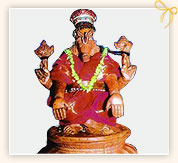 Lord Hayagriva is a form of Lord Vishnu. In
Sanskrit, 'Haya' means horse, and 'griva' means neck. Lord
Hayagriva has the head and neck of a horse and the body of a
divine being. Lord Vishnu is said to have incarnated as Lord
Hayagriva when two demons named Madhu and Kaitabha stole the
Vedas from Lord Brahma, the Cosmic Creator. Lord Hayagriva
killed the demons and restored the Vedas.
Lord Hayagriva is a form of Lord Vishnu. In
Sanskrit, 'Haya' means horse, and 'griva' means neck. Lord
Hayagriva has the head and neck of a horse and the body of a
divine being. Lord Vishnu is said to have incarnated as Lord
Hayagriva when two demons named Madhu and Kaitabha stole the
Vedas from Lord Brahma, the Cosmic Creator. Lord Hayagriva
killed the demons and restored the Vedas.
Lord Hayagriva is the embodiment of bliss and knowledge. Lord Hayagriva blesses his devotees with knowledge, and a prosperous family life. His devotees are sure to find enlightenment at the lotus feet of Lord Hari.Lord Indra
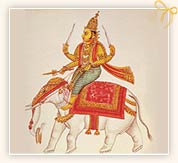 Indra is the chief god of Rig Veda. Indra
is the leader of Devas. Lord Indra is the god of war, storms
and thunder, he is strongest of all beings and greatest of
all warriors. Lord Indra has been the protector of Gods and
mankind against the evil forces. Possessing the celestial
weapon Vajra, the lightning bolt, Lord Indra is known as the
God of thunder. He also has a bow, a hook and a net in the
battle. Lord Indra is also considered as the creator, since
he is the one who brought water to earth, he is known as the
fertility god as well. Lord Indra is also believed to have
the power to revive slain warriors who had fallen in battle.
He enjoys drinking soma. Lord Indra is very handsome, he is
the eldest son of Kasyapa and Aditi. His vahana-vehicle is a
white colored elephant called Eravat.
Indra is the chief god of Rig Veda. Indra
is the leader of Devas. Lord Indra is the god of war, storms
and thunder, he is strongest of all beings and greatest of
all warriors. Lord Indra has been the protector of Gods and
mankind against the evil forces. Possessing the celestial
weapon Vajra, the lightning bolt, Lord Indra is known as the
God of thunder. He also has a bow, a hook and a net in the
battle. Lord Indra is also considered as the creator, since
he is the one who brought water to earth, he is known as the
fertility god as well. Lord Indra is also believed to have
the power to revive slain warriors who had fallen in battle.
He enjoys drinking soma. Lord Indra is very handsome, he is
the eldest son of Kasyapa and Aditi. His vahana-vehicle is a
white colored elephant called Eravat.
Lord Jagannath
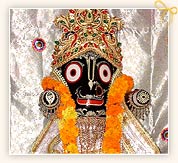 Lord Jagannath is the Lord of the world.
The word Jagannath literally means lord of the universe.
Lord Jagannath is the symbol of universal love and
brotherhood. Jagannath is particular form of Lord Vishnu, or
more accurately that of Lord Krishna. The image of Lord
Jagannath has no legs just has stump of hands. The idol is
black in color. Lord Jagannath is worshiped along with his
brother Balabhadra and sister Suvadra. Lord Balabhadra is
the elder brother, Lord Jagannath is younger brother and
Devi Suvadra is younger sister. Puri, in Orissa is
considered the real abode of Lord Jagannath. It is believed
that Lord Jagannath symbolizes cosmic zero and that Lord is
omnipotent, omnipresent and omniscient. The Jagannath cult
has people of all religion and faith.
Lord Jagannath is the Lord of the world.
The word Jagannath literally means lord of the universe.
Lord Jagannath is the symbol of universal love and
brotherhood. Jagannath is particular form of Lord Vishnu, or
more accurately that of Lord Krishna. The image of Lord
Jagannath has no legs just has stump of hands. The idol is
black in color. Lord Jagannath is worshiped along with his
brother Balabhadra and sister Suvadra. Lord Balabhadra is
the elder brother, Lord Jagannath is younger brother and
Devi Suvadra is younger sister. Puri, in Orissa is
considered the real abode of Lord Jagannath. It is believed
that Lord Jagannath symbolizes cosmic zero and that Lord is
omnipotent, omnipresent and omniscient. The Jagannath cult
has people of all religion and faith.
Lord Kalki
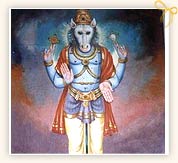 According to Hindu mythology Lord Kalki is
the tenth and final re-incarnation of Lord Vishnu who is not
yet born. Lord Kalki is the protector of good. It is a
strong belief according to Hindu myhthology that Lord Kalki
takes birth in this planet in Kalyug {time after death of
Lord Krishna around 3000bc}. Klayug is believed to be a time
of wars, deciet, and peaceless attrocities. It is said that
it is this time that Lord will reincarnate himself as Kalki
and save the world from pain and troubles. The Kalki temple
in Jaipur is the only temple that is built in the name of an
incarnation who is not yet born. Kalki actually means born
of time. It is believed that Lord Kalki will come in a white
horse with a shining sword in his hand and will protect
mankind from the chaos and evils of kalyug.
According to Hindu mythology Lord Kalki is
the tenth and final re-incarnation of Lord Vishnu who is not
yet born. Lord Kalki is the protector of good. It is a
strong belief according to Hindu myhthology that Lord Kalki
takes birth in this planet in Kalyug {time after death of
Lord Krishna around 3000bc}. Klayug is believed to be a time
of wars, deciet, and peaceless attrocities. It is said that
it is this time that Lord will reincarnate himself as Kalki
and save the world from pain and troubles. The Kalki temple
in Jaipur is the only temple that is built in the name of an
incarnation who is not yet born. Kalki actually means born
of time. It is believed that Lord Kalki will come in a white
horse with a shining sword in his hand and will protect
mankind from the chaos and evils of kalyug.
Lord Kamdev
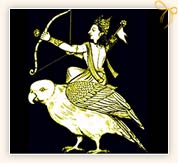 Lord Kamdev is the Hindu god of love.
Kamdev is symbolized as a young and good looking man with
wings who possesses bow and arrows. According to Shivpuran,
Kamdev is a son meaning a creation of Bramha, creator of the
universe. According to Hindu mythology Kamdeva is a brother
of Prasuti, they both are children of Shatarupa, also a
creation of Bramha. Lord Kamdev's bow is made of sugarcane
with honeybees sitting on it. The arrows are beautifully
decorated with five kinds of sweet smelling flowers. The
string of the bow is made of a chain of honeybees. Parrot,
cuckoo and humming bees are his companions.
Lord Kamdev is the Hindu god of love.
Kamdev is symbolized as a young and good looking man with
wings who possesses bow and arrows. According to Shivpuran,
Kamdev is a son meaning a creation of Bramha, creator of the
universe. According to Hindu mythology Kamdeva is a brother
of Prasuti, they both are children of Shatarupa, also a
creation of Bramha. Lord Kamdev's bow is made of sugarcane
with honeybees sitting on it. The arrows are beautifully
decorated with five kinds of sweet smelling flowers. The
string of the bow is made of a chain of honeybees. Parrot,
cuckoo and humming bees are his companions.
Lord Kartikeya
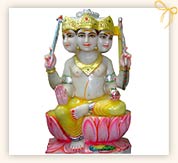 Kartikeya is the second son of Lord Shiva
and Goddess Parvati or Shakti. He is known by many names
like, Skanda, Subramaniam, Shadanana, Guha, Sanmukha meaning
having six faces. Lord Kartikeya symbolizes a person of
perfection. He is the war God and was created by all the
Gods to bring an end to the demons. Lord Kartikeya is very
masculine and fierce. He is also regarded as fire and is
very fiery in nature. The Lord has a spear in his hand
called Sakti which represents the destruction of evil and
with his other hand he is found blessing his devotees. In
south India Lord Kartikeya is very popular and is known as
Murugan. Lord Kartikeya's vehicle or Vahana is a peacock
that has the capacity of killing serpents [representing ego
and desires of people] by gripping in his feet. Thus the
peacock represents the destroyer of harmful and sensual
desires of humans.
Kartikeya is the second son of Lord Shiva
and Goddess Parvati or Shakti. He is known by many names
like, Skanda, Subramaniam, Shadanana, Guha, Sanmukha meaning
having six faces. Lord Kartikeya symbolizes a person of
perfection. He is the war God and was created by all the
Gods to bring an end to the demons. Lord Kartikeya is very
masculine and fierce. He is also regarded as fire and is
very fiery in nature. The Lord has a spear in his hand
called Sakti which represents the destruction of evil and
with his other hand he is found blessing his devotees. In
south India Lord Kartikeya is very popular and is known as
Murugan. Lord Kartikeya's vehicle or Vahana is a peacock
that has the capacity of killing serpents [representing ego
and desires of people] by gripping in his feet. Thus the
peacock represents the destroyer of harmful and sensual
desires of humans.
Lord Krishna
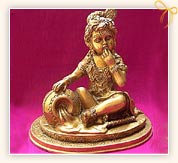 According to various Hindu traditions, Lord
Krishna is regarded as the eighth avatar of Lord Vishnu. He
is known for his bravery in destroying evil powers
throughout his life. Lord Krishna is worshiped by Hindus all
across the world. In the Bhagavad Gita, Lord Krishna is seen
as the Supreme Person and the highest God.
According to various Hindu traditions, Lord
Krishna is regarded as the eighth avatar of Lord Vishnu. He
is known for his bravery in destroying evil powers
throughout his life. Lord Krishna is worshiped by Hindus all
across the world. In the Bhagavad Gita, Lord Krishna is seen
as the Supreme Person and the highest God.
The Lord is usually depicted as playing the flute (Murali), which symbolizes spreading the melody of love to people.
In most of his idols, Lord Krishna is also represented with his childhood devotee Radha. The Lord is usually remembered and worshipped as Radha-Krishna. The pair symbolizes the eternal love between people and god. Lord Krishna is also shown with his pet cow, his childhood favorite. Lord Krishna performed many divine sports (leela) during his childhood.
Different types of materials used for crafting the idol of Lord Krishna include :- Ashtadhatu
- Stone
- Brass
- Parad
The height and weight of these idols varies on the basis of the material used for carving them.
The idols of Shree Krishna are available in various styles and postures. Some of the common styles are :
Radha Krishna Jhoola Idol
This is a very lovely idol, usually crafted in brass that depicts Lord Krishna and his beloved Radha together in a Jhoola (swing). This type of idol reflects a unique example of love and devotion.
Baby Krishna Idol
This type of idol depicts child Krishna childhood who is known for his naughtiness and mischievous acts. In his childhood, Lord Krishna was known as Makhan Chor, the one who used to steal butter from cowherd damsels in his neighbourhood.
Ladoo Gopal Idol
Lord Krishna was lovingly called "Ladoo Gopal" in his childhood. This type of idol of Lord Krishna depicts the childhood with the Lord holding a ladoo that symbolizes happiness and joy to the world.Lord Kuber
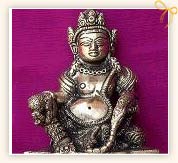 Lord Kuber, also known as Kuvera is
considered as the actual God of wealth, money and success in
Indian mythology. He is the Lord of all treasures and the
god's treasurer. Kuber is also known as the God of
Yakshas (savage beings). Kuber is the actual Lord of
Riches in the Indian pantheon (Lakshmi being the goddess of
fortune of which money is a great part).
Lord Kuber, also known as Kuvera is
considered as the actual God of wealth, money and success in
Indian mythology. He is the Lord of all treasures and the
god's treasurer. Kuber is also known as the God of
Yakshas (savage beings). Kuber is the actual Lord of
Riches in the Indian pantheon (Lakshmi being the goddess of
fortune of which money is a great part).
Kuber is worshipped as a God who protects and conserves wealth in a family. It is believed that worshiping Kuber idol regularly along with Kuber yantra ensures fast results and blesses the natives with prosperity, wealth and goodluck. He is the basis of gain of unlimited wealth and prosperity.
According to ancient vedic books of Ramayana, Kuber made the Gold Lanka, which was taken by his brother Ravana. All ancient texts encourage the use of Kuber Sadhana for the gain of wealth. It is said that Lord Kuber blesses the Sadhak with material success and wealth. Our Vedas and ancient texts encourage the use of Kuber sadhana for the gain of wealth.
It is believed that there are three main benefits form Kuber Sadhana. Firstly, when Lord Kuber is pleased, he blesses the devotee with material success and wealth. Secondly, there are increased chances of getting wealth unexpectedly and suddenly. Thirdly, no matter how much one spends money keeps flowing in, provided the wealth is used for constructive purposes and not for destructive or antisocial activities Kuber Sadhana is short and simple but its effects are amazing if one tries it with true belief and faith.
Lord Kubera idol is usually made of :- Astadhatu
- Brass
- Stone
Lord Kurma
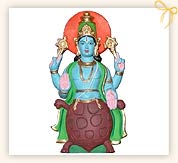 Lord Kurma or Koorm is the second
incarnation of Lord Vishnu in the form of a Tortoise.
According to the legend it is believed that mountain Mandara
was used as a churning stick and it began to sink in the sea
bed. This crisis made Lord Vishnu assume the form of a
tortoise. Then Lord dived into the bottom of the sea and his
back served as the pivot for the churning stick. The
incarnation in the form of Kurma symbolizes the development
of life. This is so because when the ability to breathe air
and walk out of water developed hence the turtle became the
symbol of perseverance.
Lord Kurma or Koorm is the second
incarnation of Lord Vishnu in the form of a Tortoise.
According to the legend it is believed that mountain Mandara
was used as a churning stick and it began to sink in the sea
bed. This crisis made Lord Vishnu assume the form of a
tortoise. Then Lord dived into the bottom of the sea and his
back served as the pivot for the churning stick. The
incarnation in the form of Kurma symbolizes the development
of life. This is so because when the ability to breathe air
and walk out of water developed hence the turtle became the
symbol of perseverance.
Lord Laxman
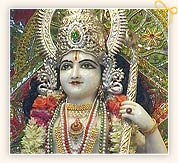 Lord Laxman is the younger brother of Lord
Rama. His performance of duties as a younger brother is that
of sacrifice and superior character, such duties are
actually difficult to perform. Lord Laxmana was very
dedicated and loyal to his elder brother Lord Rama. In
comparison to Lord Rama, Laxmana is shot tempered. But
Laxmana is also considered as a vital element of Mariyada
Purushottam, as he had displayed presence of mind and
courage when Rama had become desperate and angry over the
loss of Sita. In such a situation Laxmana had displayed a
matured behavior and had calmed Lord Rama. Lord Laxmana's
life is a symbol of duties performed by a man towards his
elders and also depicts the nature of selflessness in a
man's character.
Lord Laxman is the younger brother of Lord
Rama. His performance of duties as a younger brother is that
of sacrifice and superior character, such duties are
actually difficult to perform. Lord Laxmana was very
dedicated and loyal to his elder brother Lord Rama. In
comparison to Lord Rama, Laxmana is shot tempered. But
Laxmana is also considered as a vital element of Mariyada
Purushottam, as he had displayed presence of mind and
courage when Rama had become desperate and angry over the
loss of Sita. In such a situation Laxmana had displayed a
matured behavior and had calmed Lord Rama. Lord Laxmana's
life is a symbol of duties performed by a man towards his
elders and also depicts the nature of selflessness in a
man's character.
Lord Mangal
 Lord Mangal (Mars) is one of the nine
planets or navagrahas. He is also known by the names
Angaraka and Kuja. According to Vedic mythology, Lord Mangal
is born of Sarva and Vikesi (Earth goddess). He is
associated with strength, valor, and courage. Lord Mangal is
the protector of dharma (righteousness), and the purpose of
life.
Lord Mangal (Mars) is one of the nine
planets or navagrahas. He is also known by the names
Angaraka and Kuja. According to Vedic mythology, Lord Mangal
is born of Sarva and Vikesi (Earth goddess). He is
associated with strength, valor, and courage. Lord Mangal is
the protector of dharma (righteousness), and the purpose of
life.
Lord Mangal has four hands, and carries a trident and mace as weapons. He wears red ornaments. Worshiping Lord Mangal frees one from skin illnesses, debts, and poverty. The gemstone of Lord Mangal is the red coral, and his day is Tuesday. He is the guardian of the south direction.Lord Rama
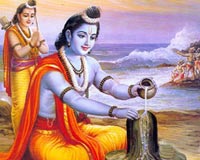 Lord Rama is one of the most commonly
adored gods of Hindus and is known as an ideal man and hero
of the epic Ramayana. He is one of the most popular heroes
of Hindu mythology and folktales in South and Southeast
Asia.
Lord Rama is one of the most commonly
adored gods of Hindus and is known as an ideal man and hero
of the epic Ramayana. He is one of the most popular heroes
of Hindu mythology and folktales in South and Southeast
Asia.
Lord Rama is always represented holding a bow and arrow indicating his readiness to destroy evils. He is also called "Shri Rama" and is regarded as the most famous incarnation Lord Vishnu. More commonly he is pictured in a family style, (Ram Parivar) with his wife Sita, brother Lakshman and devotee Hanuman who is sitting near Lord Rama's feet.
Ram Darbar
Ram Darbar constitutes of Lord Rama, Goddess Sita, his wife, Lord Lakshman, his younger brother and his ardent devotee - Lord Hanuman. Lord Rama is regarded as an incarnation of Lord Vishnu as a great King. Sita is his eternal consort and an incarnation of Lakshmi.
The idol of Lord Rama is usually made of :- Ashtadhatu
- Stone
The height and weight of idols of Lord Rama varies according to the material used for crafting these idols.
Lord Shani
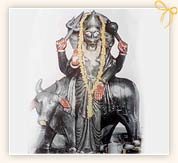 Lord Shani is one of the navagrahas (nine
planets). He is also referred to as Saturn. He is also known
as Shaneeshwara, Shani Bhagawan, Saneeswaran, Lord Sani and
so on. Lord Shani is the son of Lord Surya (the sun god).
According to Hindu mythology, after Sanjana (daughter of
Lord Vishwakarma) married Lord Surya, she found the power of
his rays hard to bear. After giving birth to three children,
she decided to leave for her parents' place. Before she
left, she created a woman from her own shadow and named her
Chayadevi. Lord Shani is the result of the union between
Lord Surya and Chhayadevi (also known as Chhaya).
Lord Shani is one of the navagrahas (nine
planets). He is also referred to as Saturn. He is also known
as Shaneeshwara, Shani Bhagawan, Saneeswaran, Lord Sani and
so on. Lord Shani is the son of Lord Surya (the sun god).
According to Hindu mythology, after Sanjana (daughter of
Lord Vishwakarma) married Lord Surya, she found the power of
his rays hard to bear. After giving birth to three children,
she decided to leave for her parents' place. Before she
left, she created a woman from her own shadow and named her
Chayadevi. Lord Shani is the result of the union between
Lord Surya and Chhayadevi (also known as Chhaya).
When Lord Shani was born, the sun went into an eclipse. Lord Shani is said to be the enemy of light. He is associated with the color black. The crow is Lord Shani's vehicle. His gems are the blue sapphire (neelam), and all black gems. His metal is lead, and he is the lord of Saturday.Lord Sheshnag
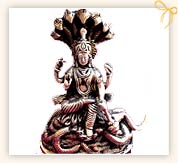 Lord Sheshnag is depicted is the divine
serpent with a thousand heads. According to Hindu mythology,
the world rests on the hoods of Lord Sheshnaga, and when he
shakes his head, there are earthquakes. He is also known as
Ananta (eternal) since he is immortal and is not affected by
death even during the destruction of the Universe.
Lord Sheshnag is depicted is the divine
serpent with a thousand heads. According to Hindu mythology,
the world rests on the hoods of Lord Sheshnaga, and when he
shakes his head, there are earthquakes. He is also known as
Ananta (eternal) since he is immortal and is not affected by
death even during the destruction of the Universe.
Lord Vishnu reclines on the coils of Lord Sheshnag in the Ksheersagar, or the Ocean of Milk. Lord Sheshnag is also considered to be the soul of Lord Vishnu when he incarnated as Lord Balaram.Lord Shiva
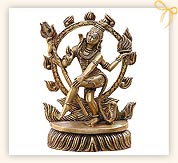 Lord Shiva is one of the main Deities of
Hinduism. He is the Supreme God in Shaivism, one of the
major branches of Hinduism practiced in India. Lord Shiva is
worshipped as the paramount lord by the Saivite sect of
India. He is considered as the destroyer and the restorer,
the great ascetic and the symbol of sensuality. Lord Shiva
is a part of the trinity or trimurti of Hindu gods.
Lord Shiva is one of the main Deities of
Hinduism. He is the Supreme God in Shaivism, one of the
major branches of Hinduism practiced in India. Lord Shiva is
worshipped as the paramount lord by the Saivite sect of
India. He is considered as the destroyer and the restorer,
the great ascetic and the symbol of sensuality. Lord Shiva
is a part of the trinity or trimurti of Hindu gods.
Even though he represents destruction, Lord Shiva is viewed as a positive force (the Destroyer of Evil). According to Shaivism, Shiva is not merely a destroyer but performs five functions :- Creator Preserver
- Destroyer
- Hiding the sins
- Blessing
Lord Shiva is usually represented by the Shiva linga (or lingam), which is depicted by a clay mound with three horizontal stripes on it, or visualised as a blazing pillar.
God Shiva is known by various names. One of his names is Bholenath, which means the innocent God. Shiva as Rudra is regarded as the destroyer of evil and sorrow. Shiva as Shankara is known as the doer of good. Lord Shiva has "Trinetra" (divine vision). He is also known as "Nilakantha" (blue necked). This is because of the fact that he consumed the poison 'Halahala' to save the world from destruction. Lord Shiva as Nataraja represents the Divine Cosmic Dancer. Shiva is also known as Ardh narishvara, which symbolises both man and woman.
Lord Shiva idols are crafted out of various materials like :- Stone
- Wood
- Ashtadhatu
- Sphatik/Crystal
- Parad/Mercury
The height and weight of Shiva Idols are variable and depends on the material used for making the idol.
Idols of Lord Shiva are available in following style :
Shiva Parivar
Shiva Parivar is a combination of 5 statues comprising the family of Lord Shiva. It includes Lord Shiva(in the form of shivlinga), Goddess Parvati, their two sons - Ganesha and Kartikeya and Shiva's vehicle - the Nandi Bull. It is said that the regular worship of Shiva Parivar results in prosperity and good health.
The idol of Shiva Parivar is usually available in Sphatik and ParadLord Shukra
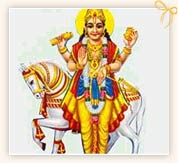 Lord Shukra is a part of the nine planets
(navagrahas). He is the planet Venus. According to Hindu
scriptures, he is born from the union of Sage Bhrigu and his
wife Ushana (also known as Usha). Lord Shukra is blessed by
Lord Brahma (the Cosmic Creator), he showers his devotees
with abundance.
Lord Shukra is a part of the nine planets
(navagrahas). He is the planet Venus. According to Hindu
scriptures, he is born from the union of Sage Bhrigu and his
wife Ushana (also known as Usha). Lord Shukra is blessed by
Lord Brahma (the Cosmic Creator), he showers his devotees
with abundance.
Lord Shukra is pictured as a fair god. He has four hands, and is seated on a white lotus. He rides a chariot driven by eight horses. Lord Shukra is also known as Shukracharya. He bestows prosperity, wealth, knowledge, and happiness. Diamond is the gem of Lord Shukra. His metals are copper and silver. His ruling day is Friday, and he is the guardian of the south-east direction.Lord Skanda
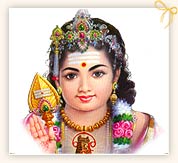 Lord Skanda is the spiritual son of Lord
Shiva. He is also known as Kartikeya or Murugan Skanda. Lord
Skanda has six faces and twelve arms. This avtar of Lord was
granted by Lord Shiva to protect the Gods from the Demons.
This great son of Lord Shiva became the leader of the
celestial forces. The battle was won by the Gods under the
able guidance of Lord Skanda. The spiritual significance of
Lord Skanda is the supremity of supreme efficacy, sincere
prayer and self surrender.
Lord Skanda is the spiritual son of Lord
Shiva. He is also known as Kartikeya or Murugan Skanda. Lord
Skanda has six faces and twelve arms. This avtar of Lord was
granted by Lord Shiva to protect the Gods from the Demons.
This great son of Lord Shiva became the leader of the
celestial forces. The battle was won by the Gods under the
able guidance of Lord Skanda. The spiritual significance of
Lord Skanda is the supremity of supreme efficacy, sincere
prayer and self surrender.
Lord Surya
Lord Surya is the ruler of all planets that rotate around him. Lord Surya is also known by other names like Savitar, Aditya, and Ravi. He is the son of Sage Kashyap and Aditi. He is described as Jagat Chakshu (Eye of the World), and Aharpati (Lord of the Day). The sun's rays nourish and nurture life and living beings. Hence, he is described as 'Pranadata' or life-giver.
Lord Surya is the guardian of the east. He blesses his devotees with good health, fame, and prosperity. His ruling day is Sunday. His gemstone is the red ruby, and gold is his metal. The chariot of Lord Surya has only one wheel. It is drawn by seven horses corresponding to the colors of the rainbow. The charioteer of Lord Surya is Aruna, Lord Garuda's brother.Lord Varaha
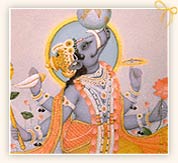 The third avtar of Lord Vishnu is known as
Lord Varaha. This avtar is in the form of a boar who was
sent to defeat Hiranyaksha, a demon who had carried the
Earth to the bottom of the cosmic ocean. The battle is
believed to take place for thousands of years and Lord
Varaha won the battle. Lord Varaha has the face of a boar
and a man's body. The avtar depicts the reconstruction of
the Earth from a deluge and the establishment of a new
cycle. Lord Vishnu married Bhudevi [Prithvi] in this avtar.
The third avtar of Lord Vishnu is known as
Lord Varaha. This avtar is in the form of a boar who was
sent to defeat Hiranyaksha, a demon who had carried the
Earth to the bottom of the cosmic ocean. The battle is
believed to take place for thousands of years and Lord
Varaha won the battle. Lord Varaha has the face of a boar
and a man's body. The avtar depicts the reconstruction of
the Earth from a deluge and the establishment of a new
cycle. Lord Vishnu married Bhudevi [Prithvi] in this avtar.
Lord Vayu
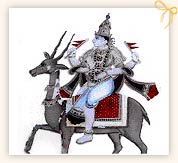 Lord Vayu is the god of wind. He belongs to
the Cosmic Trinity or Hindu Triad (Sun, Fire, Air), and
constitutes one of the five elements of the Universe, i.e.
earth, air, water, fire, and space. Lord Vayu is said to
have been born from the breath or life force of the Supreme
Being. Lord Vayu is also described as 'satata-ga' (ever
moving), 'pavana' (wind), and 'gandha-vaha' (the perfume
bearer).
Lord Vayu is the god of wind. He belongs to
the Cosmic Trinity or Hindu Triad (Sun, Fire, Air), and
constitutes one of the five elements of the Universe, i.e.
earth, air, water, fire, and space. Lord Vayu is said to
have been born from the breath or life force of the Supreme
Being. Lord Vayu is also described as 'satata-ga' (ever
moving), 'pavana' (wind), and 'gandha-vaha' (the perfume
bearer).
Lord Vayu is considered the king of the Gandharvas (spirits of the atmosphere/sky). He is said to be fierce and fast. He roams all over the earth, and heavens. Lord Vayu is also amorous and has a rash nature. He is said to have blown the top of the mythical Mount Meru which fell into the sea, and is the present day Lanka (Ceylon). Lord Vayu is the father of Lord Hanuman. He is the guardian of the north-west direction.Lord Vishnu
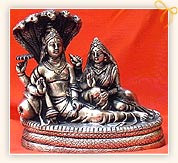 Lord Vishnu is regarded as a major god in
Hinduism and Indian mythology. He is considered as the
Preserver of the universe and is the member of the Trinity
of Gods in Hinduism. The idol of Lord Vishnu is represented
as the God having four hands. The first hand holds a conch
shell (sankha) indicating spread of the divine sound
"Om"; the second hand holds a discus (chakra), which
symbolises the wheel of time; the third one holds a lotus
(Padma) which is an example of glorious existence and
the fourth hand holds a mace (Gada) indicating the
power and the punishing capacity of the Lord in case the
discipline of life is ignored.
Lord Vishnu is regarded as a major god in
Hinduism and Indian mythology. He is considered as the
Preserver of the universe and is the member of the Trinity
of Gods in Hinduism. The idol of Lord Vishnu is represented
as the God having four hands. The first hand holds a conch
shell (sankha) indicating spread of the divine sound
"Om"; the second hand holds a discus (chakra), which
symbolises the wheel of time; the third one holds a lotus
(Padma) which is an example of glorious existence and
the fourth hand holds a mace (Gada) indicating the
power and the punishing capacity of the Lord in case the
discipline of life is ignored.
His vehicle is the swift-flying bird Garuda, which is capable of spreading Vedic knowledge with great courage. The consort of Lord Vishnu is Goddess Lakshmi, the Goddess of Wealth.
According to Hindu Mythology, Lord Vishnu is represented in two postures. In one, the God rests on the bed of the powerful, coiled serpent, Sheshnag, who represents the sleeping universe. In another form, Lord is depicted in a standing posture. Lord Vishnu is also known as Hari, the Remover.
Lord Vishnu is most popularly identified with his Avatars (incarnations) especially Krishna and Rama. He is also frequently referred to as Narayana.
Vaishnavite Hindus also worship Vishnu in an abstract form (i.e., God with vague form) as a Shaligrama stone. Worshiping the Shaligrama is similar to the worship of Lingam, a form of Shiva.
The idol of Lord Vishnu is usually made of the following materials :- Ashtadhatu
- Brass
- Stone
- Parad/Mercury
The height and weight of Lord Shiva idols varies depending on the type of material used for making the idol.
Lord Vishwakarma
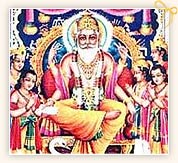 Lord Vishwakarma is known as the lord of
craftsmen. Hindus worship Lord Vishwakarma as the god of
engineering and architecture. He is the presiding deity of
goldsmiths, blacksmiths, carpenters, masons, and all people
who possess craft skills. Lord Vishwakarma is the son of
Lord Brahma, the Cosmic Creator.
Lord Vishwakarma is known as the lord of
craftsmen. Hindus worship Lord Vishwakarma as the god of
engineering and architecture. He is the presiding deity of
goldsmiths, blacksmiths, carpenters, masons, and all people
who possess craft skills. Lord Vishwakarma is the son of
Lord Brahma, the Cosmic Creator.
Lord Vishwakarma is pictured with four hands. He carries a book, a vessel, a noose, and craftsmen's tools. He is the personification of all creative power. All chariots, and divine weapons of the gods are created by Lord Vishwakarma. He built Dwarka, Yamapuri, and Lanka. He is also said to have created the image of Lord Jagannath and left it incomplete due to interruption.Lord Yama
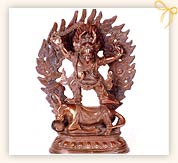 Lord Yama or Yamraj, is the god of death.
He is the son of Lord Surya and Sanjana. 'Yama' means twin,
and this can be attributed to Hindu mythology where he is
depicted as the twin brother of Yami (Yamuna). However,
'Yama' also means 'the restrainer'. So it is Lord Yama who
restrains humankind. Lord Yama is the god of hell.
Lord Yama or Yamraj, is the god of death.
He is the son of Lord Surya and Sanjana. 'Yama' means twin,
and this can be attributed to Hindu mythology where he is
depicted as the twin brother of Yami (Yamuna). However,
'Yama' also means 'the restrainer'. So it is Lord Yama who
restrains humankind. Lord Yama is the god of hell.
Lord Yama is shown with a grim appearance with a glittering crown on his head. He carries a mace in one hand, and a rope in the other. He uses the rope to pull the soul from the lifeless body. He is also considered as the Lord of Justice, a judge of the dead. According to the karma of the soul, he decide whether to give punishment, and the nature of punishment. Lord Yama rides a black water buffalo. He is the guardian of the south direction.Planet Ketu
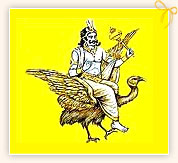 Ketu is the imaginary headless planet which
represents spirituality. It is the south node of the moon.
According to the Puranas, after the primeval ocean was
churned, Lord Dhanvantri appeared with a pot of Nectar. This
was the Nectar of Immortality. Lord Vishnu was distributing
this nectar amongst the gods, when the celestial serpent
demon Rahu mingled amidst the gods so he could drink the
Nectar of Immortality (Amrita). The sun and moon gods (Surya
and Chandra) saw through his deception and notified Lord
Vishnu.
Ketu is the imaginary headless planet which
represents spirituality. It is the south node of the moon.
According to the Puranas, after the primeval ocean was
churned, Lord Dhanvantri appeared with a pot of Nectar. This
was the Nectar of Immortality. Lord Vishnu was distributing
this nectar amongst the gods, when the celestial serpent
demon Rahu mingled amidst the gods so he could drink the
Nectar of Immortality (Amrita). The sun and moon gods (Surya
and Chandra) saw through his deception and notified Lord
Vishnu.
Lord Vishnu cut off Rahu's head in a fit of rage, but Rahu had already drunk the Nectar and was immortalized. Thus, his immortal head was severed from the immortal body/tail. Rahu and Ketu are the severed head and tail of the same demon. The immortal tail is known as Ketu or dragon tail. Ketu causes lunar eclipse. The gem of Ketu is Cat's eye.Planet Rahu
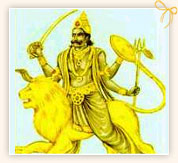 Rahu is the imaginary planet, the north
node of the moon. According to the Puranas, when the Ocean
of Milk was churned, the Nectar of Immortality was produced.
While Lord Vishnu was distributing this nectar amongst the
gods, the celestial serpent demon Rahu mingled amidst the
gods so that he could taste the nectar and attain
immortality (Amrita). The sun and moon gods (Surya and
Chandra) saw through Rahu's deception. When they notified
Lord Vishnu, he (Vishnu) cut off Rahu's head in a fit of
rage, but Rahu had already drunk the Nectar and was
immortalized.
Rahu is the imaginary planet, the north
node of the moon. According to the Puranas, when the Ocean
of Milk was churned, the Nectar of Immortality was produced.
While Lord Vishnu was distributing this nectar amongst the
gods, the celestial serpent demon Rahu mingled amidst the
gods so that he could taste the nectar and attain
immortality (Amrita). The sun and moon gods (Surya and
Chandra) saw through Rahu's deception. When they notified
Lord Vishnu, he (Vishnu) cut off Rahu's head in a fit of
rage, but Rahu had already drunk the Nectar and was
immortalized.
Rahu now refers to the head of the demon. It is also known as 'dragon head'. It is the planet of success. Rahu is associated with the strengthening of personal power. The gemstone of Rahu is hessonite. Rahu causes solar eclipse. Rahu and Ketu are two parts of the same demon.Hindu Goddess Idols
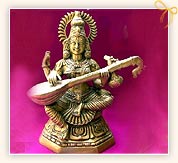 Hinduism is known for the variety of gods
and goddesses, who are worshipped in various forms. All
Hindu Gods and Goddesses are the same Supreme God or divine
energy, nameless and without form. God in the feminine form
is regarded as the goddess, the Divine Mother in Hinduism.
Hinduism is known for the variety of gods
and goddesses, who are worshipped in various forms. All
Hindu Gods and Goddesses are the same Supreme God or divine
energy, nameless and without form. God in the feminine form
is regarded as the goddess, the Divine Mother in Hinduism.
In Hinduism, many Goddesses are worshiped and some of them are :Devi Kurukulla
 Devi Kurukulla is compared to goddess Tara,
where Kurukulla in her red avtaar exercises her powers of
enchantment and bewitchment to control the evil spirits,
demons, and humans who work against the humanity and its
spiritual evolution. While if talking in terms of practical
magic, then she can bring anything imaginable under the
practitioner's power. She has the power to subjugate the
demonic forces. In Tibet, she is worshiped whenever starting
a new project for her blessings. Along with goddesses
Manjushri and Sarasvati, she is worshiped by students to get
blessings.
Devi Kurukulla is compared to goddess Tara,
where Kurukulla in her red avtaar exercises her powers of
enchantment and bewitchment to control the evil spirits,
demons, and humans who work against the humanity and its
spiritual evolution. While if talking in terms of practical
magic, then she can bring anything imaginable under the
practitioner's power. She has the power to subjugate the
demonic forces. In Tibet, she is worshiped whenever starting
a new project for her blessings. Along with goddesses
Manjushri and Sarasvati, she is worshiped by students to get
blessings.
As per mythology, Kurukulla is sixteen years old since sixteen is considered an ideal number signifying perfection, four times four. She is depicted naked as unconditioned by destructive thoughts. The garland made of human bones adorns her persona. She signifies the sixth perfection. Like Kali, she is also shown in a dancing pose upon a male corpse, thus, signifying her active and energetic & compassionate activity highlighted in both Samsara and Nirvana.Goddess Aditi
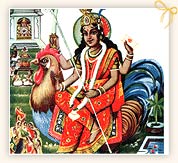 Aditi, the Hindu great Goddess, is
considered the Goddess of Sun. Her attribute is her
motherhood. She represents the wide horizon. She is the
free-spirited goddess andas per the Vedas, she was once
all-encompassing. She was known as the goddess of the past
and the future, the life cycle, the seven dimensions of the
cosmos, the celestial light which permeates all things, and
the consciousness of all living things. Later, she was known
for giving birth to the Adityas. Though she is also said to
have given birth to the twelve zodiacal spirits. She is even
known as the consort of Brahma. She is symbolized through
the form of a cow as well. Eventually, Aditi was degraded as
a guardian goddess who helped her worshipers find a smooth
path to what they were looking for.
Aditi, the Hindu great Goddess, is
considered the Goddess of Sun. Her attribute is her
motherhood. She represents the wide horizon. She is the
free-spirited goddess andas per the Vedas, she was once
all-encompassing. She was known as the goddess of the past
and the future, the life cycle, the seven dimensions of the
cosmos, the celestial light which permeates all things, and
the consciousness of all living things. Later, she was known
for giving birth to the Adityas. Though she is also said to
have given birth to the twelve zodiacal spirits. She is even
known as the consort of Brahma. She is symbolized through
the form of a cow as well. Eventually, Aditi was degraded as
a guardian goddess who helped her worshipers find a smooth
path to what they were looking for.
Goddess Bhavani
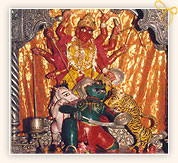 Bhavani in Hindu mythology is considered as
a ferocious goddess Shakti or Devi. She connotes "giver of
life", nature's power as well the source of creative energy.
She is even known by Karunaswaroopini, meaning "filled with
mercy". The other names by which is known are Tulaja,
Turaja, Tvarita and Amba.
Bhavani in Hindu mythology is considered as
a ferocious goddess Shakti or Devi. She connotes "giver of
life", nature's power as well the source of creative energy.
She is even known by Karunaswaroopini, meaning "filled with
mercy". The other names by which is known are Tulaja,
Turaja, Tvarita and Amba.
She was the tutelary deity of the Maratha leader, Shivaji. Due to this, she is worshiped in high reverence throughout Maharashtra. Legend says that the goddess slained the notorious demon, Mahishasura who had wrecked havoc upon the devas & the humans.
The other legend suggests that a demon camouflaged himself in the form of a wild buffalo, known as Mahisha, & took abode on the Yamunachala hill. The goddess slained the demon to reestablish peace &, thus, a temple devoted to her was built on the hill.Goddess Chomolungma
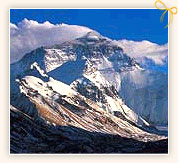 Chomolungma goddess is the name given to
Mt. Everest, where she is supposed to inhabit. She is one of
five sisters associated with mountains situated above sacred
lakes, along the Nepal/Tibet frontier. As per the legend,
Chomolungma or Miyolangsangma is a part of a group of
wrathful Bon deities, the srungma. She was subdued by the
evangelising zeal of Guru Rinpoche to act as a servant of
Buddhism. Ever since, she has become the symbol of a
generous benefactor.
Chomolungma goddess is the name given to
Mt. Everest, where she is supposed to inhabit. She is one of
five sisters associated with mountains situated above sacred
lakes, along the Nepal/Tibet frontier. As per the legend,
Chomolungma or Miyolangsangma is a part of a group of
wrathful Bon deities, the srungma. She was subdued by the
evangelising zeal of Guru Rinpoche to act as a servant of
Buddhism. Ever since, she has become the symbol of a
generous benefactor.
The Sherpas on Everest ritually pay their homage to the goddess in order to keep on her good side since anything offensive may such as morally questionable behaviour can provoke her wrath. Even in the past, she was seen as the deity of a wealth-giver & thus, she still holds that same position in the region.Goddess Devi
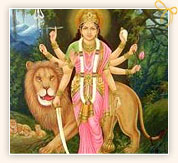 Devi is a Sanskrit word meaning Goddess
which is synonymous with Shakti, the female aspect of
divinity. In the Shakta tradition, she is seen as the
driving force without which the male aspect is considered
impotent. She is even known by many names in the of the
Hindu culture. The Divine Mother has forms like that of the
warrior Durga and the bloodthirsty Kali. She at the same
time can be gentle as Parvati or mother of the elephant god
Ganesha. She is the better half of Shiva, i.e. Parvati. Devi
is considered to be the "Mother Goddess", thus, meaning the
mother of all. Her right hand interprets joy and pain while
the left hand means life and death. She is seen as the god
of nature and life since she brings rain and is a savior as
from death. She is even worshiped for her mild and loving
nature. She could be terrible as a Mother of Death. Her
divine vehicle is either lion or tiger whenever she is
fighting the evil. In a nutshell, she is the goddess of
creative power and represents all women in the universe
Devi is a Sanskrit word meaning Goddess
which is synonymous with Shakti, the female aspect of
divinity. In the Shakta tradition, she is seen as the
driving force without which the male aspect is considered
impotent. She is even known by many names in the of the
Hindu culture. The Divine Mother has forms like that of the
warrior Durga and the bloodthirsty Kali. She at the same
time can be gentle as Parvati or mother of the elephant god
Ganesha. She is the better half of Shiva, i.e. Parvati. Devi
is considered to be the "Mother Goddess", thus, meaning the
mother of all. Her right hand interprets joy and pain while
the left hand means life and death. She is seen as the god
of nature and life since she brings rain and is a savior as
from death. She is even worshiped for her mild and loving
nature. She could be terrible as a Mother of Death. Her
divine vehicle is either lion or tiger whenever she is
fighting the evil. In a nutshell, she is the goddess of
creative power and represents all women in the universe
Goddess Durga
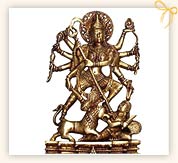 Parvati is the Shakti (power) and
consort of Lord Shiva, the god of disintegration and
destruction. A majority of goddesses of Hinduism are aspects
and variations of Parvati. She is known by different names
like Uma, Gauri, Kali, Durga, Haimavati etc. Like her
consort Shiva, Parvati also has two aspects, the mild and
the terrible.
Parvati is the Shakti (power) and
consort of Lord Shiva, the god of disintegration and
destruction. A majority of goddesses of Hinduism are aspects
and variations of Parvati. She is known by different names
like Uma, Gauri, Kali, Durga, Haimavati etc. Like her
consort Shiva, Parvati also has two aspects, the mild and
the terrible.
There are three major aspects of Devi Parvati or Shakti Durga, Kali and Lalita. Durga and Kali represent the aspects of power of the goddess and Lalita represents the aspect of beauty.
Goddess Durga is the most widely worshipped aspect of Shakti. The goddess is the reflection and manifestation of supreme beauty and deadly power and her name is synonymous with the victory of good over evil. The goddess represents the total personification power of gods. The word "Durga" literally means one who is difficult to approach or difficult to know. Being the mother of the Universe, she is the personification of tender love and possesses different forms and aspects. Goddess Durga is the mysterious power with the combination of both pleasant and terrible nature. She is the personification of knowledge, wisdom and memory and is worshiped for wealth and prosperity.
According to legends, the Gods could not defeat a buffalo-demon called "Mahisha" who could take any form. Lord Shiva advised all gods to release their "Shakti" (power) and from the combined force emerged a magnificent, many armed goddess called Devi Durga. She is called the invincible one and she defeated the demon "Mahisha" and thus saved the Universe from destruction.
The Goddess is usually depicted with eight or ten arms, each holding conch, discus, trident, bow, arrow, sword, dagger, shield, rosary, wine cup and bell. It is said that each of these weapons were given to the goddess for defeating the buffalo-demon. The Goddess may be shown as standing on a lotus or on a buffalo head or as riding a lion.
The idol of Devi Durga are usually crafted out of materials like :- Stone
- Ashtadhatu
- Wood
- Parad
- Brass
The height and weight of idols of Goddess Durga depends greatly on the material used for making the idol.
Goddess Indrani
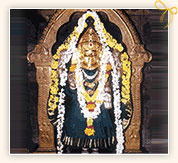 Indrani, as the name goes, was Indra's wife
& was the queen of Gods. As per the early Vedic accounts,
she was merely a female shadow of him. Sometimes referred to
as the goddess of wrath, Indrani was the daughter of a demon
called Puloman later killed by Indra. She was the epitome of
beauty with one thousand eyes. While according to the later
Hindu interpretations, she started personifying jealousy &
evil intent. She was ranked as one of the nine astral
deities who were the highest of the gods in south. The
divine vehicle for the goddess was either the lion or the
elephant.
Indrani, as the name goes, was Indra's wife
& was the queen of Gods. As per the early Vedic accounts,
she was merely a female shadow of him. Sometimes referred to
as the goddess of wrath, Indrani was the daughter of a demon
called Puloman later killed by Indra. She was the epitome of
beauty with one thousand eyes. While according to the later
Hindu interpretations, she started personifying jealousy &
evil intent. She was ranked as one of the nine astral
deities who were the highest of the gods in south. The
divine vehicle for the goddess was either the lion or the
elephant.
As per the Rig Veda, she is considered to be the most fortunate female as her husband was granted immortality. According to The Taittiriya Brahmana, Indra chose her as his wife from a number of competing goddesses simply because of her magnetic voluptuous attractions. Though, she has never been held in very high esteem as a goddess. Indrani is known as Sachi and Aindri as well.Goddess Kadru
Kadru in mythology is the daughter of Daksha, while the wife of Kashyapa. As per the Adi Parva in Mahabharata, she is considered to be the mother of the Nagas. While, according to the Ramayana, it is the other way round where she is the daughter of Kasyapa and Krodhavasa, who is another daughter of Daksha. Thus, she might be seen as Daksha's grand daughter as well.
The key point about this goddess is her being a mother of "a thousand powerful many-headed serpents, the chief amongst whom were Sesha, Vasuki and many other fierce and venomous serpents." It is considered twelve according to the Vishnu Purana while forty as per the Vayu Purana. Her offspring bear the metronymic Kadraveya.Goddess Kali
 Kali or "the black one" is the goddess
symbolizing dissolution and destruction in Hindu mythology.
She is the destroyer of ignorance who maintains the world
order while blesses and frees all those who are seeking
knowledge of God. Her name is associated with Agni,
according to Vedas, who is the god of fire & is known for
seven flickering tongues of flame. Out of these, Kali was
the black, horrible tongue. This is considered to be the
origin for the name "Kali", who is the grim consort of
Shiva. When talking about her appearance, then her fearsome
baleful eyes, protruding tongue, and four arms along with a
bloody sword in her upper left hand & a severed head in her
lower left hand, makes it the most fearful picture. She
makes the gesture of fearlessness through her upper left
hand while the lower right hand confers benefits. She is
always found draped with a chain of severed human heads & a
belt of dismembered arms gives a frightening look to her
persona. She is often shown in a dancing mode or in sexual
union with Shiva. And she stands upon the supine from her
husband to depict her Bhavatarini image, i.e. the redeemer
of the universe.
Kali or "the black one" is the goddess
symbolizing dissolution and destruction in Hindu mythology.
She is the destroyer of ignorance who maintains the world
order while blesses and frees all those who are seeking
knowledge of God. Her name is associated with Agni,
according to Vedas, who is the god of fire & is known for
seven flickering tongues of flame. Out of these, Kali was
the black, horrible tongue. This is considered to be the
origin for the name "Kali", who is the grim consort of
Shiva. When talking about her appearance, then her fearsome
baleful eyes, protruding tongue, and four arms along with a
bloody sword in her upper left hand & a severed head in her
lower left hand, makes it the most fearful picture. She
makes the gesture of fearlessness through her upper left
hand while the lower right hand confers benefits. She is
always found draped with a chain of severed human heads & a
belt of dismembered arms gives a frightening look to her
persona. She is often shown in a dancing mode or in sexual
union with Shiva. And she stands upon the supine from her
husband to depict her Bhavatarini image, i.e. the redeemer
of the universe.
Kali is known by names like Kalikamata ("black earth-mother") and Kalaratri ("black night") as well.Goddess Kauri
Kauri is considered as the avatar of the goddess Sere. She is worshiped as the Avatar of the Shadow as well. Seen as the protector of the dark hours, she even represents illusions, deception & shadows. She always left a series of legacy wherever she would take birth as a human by the name of Kauri Savina. Her life suggests two phases, as a humble healer of the Divine Muse later replaced by the position of High Priestess. But then she became the powerful Avatar of the Shadows and the Angel of Darkness. She is known by many names like Kauri Savina, Angel of the Mists, Child Thief, Flayer of Minds, Seer of the Eternity's Eye. She could hear spoken words within the shadows as per some belief. One might lose his tongue if he talks ill about the deity. Kauri seldom makes an appearance without inciting some form of chaos. While one is even blessed by the goddess if he walks in the Shadows, thus, getting the strength to fight all the odds.Goddess Kundalini
 Kundalini is actually a Sanskrit word which
means either "coiled up" or "coiling like a snake". It
emphasizes a more serpentine nature to the word, the
'serpent power'. The symbolic coiling snakes is an ancient
symbolic representation of Kundalini physiology. The symbol,
however, is believed to have originated from Hermes and
Greek mythology.
Kundalini is actually a Sanskrit word which
means either "coiled up" or "coiling like a snake". It
emphasizes a more serpentine nature to the word, the
'serpent power'. The symbolic coiling snakes is an ancient
symbolic representation of Kundalini physiology. The symbol,
however, is believed to have originated from Hermes and
Greek mythology.
Legend says that when the Goddess traveled up the spine just to meet her Divine Mate, that has been seen as the consummated union of Spirit and Matter. She is known as the Goddess Shakti. Mythological interpretation of the goddess says that whenever the Shakti is awakened, she sweeps us up in her wildest passion to reunite with her Lord Shiva in the crown chakra. This Mystical Marriage metaphorically symbolizes the combining of the male and female energies within our bodies which gives birth to our multidimensional consciousness. The procedure helps the soul in living its divine purpose through the human beings.
Goddess Kundalini cannot be remembered for curiosity or selfish reasons. The ego of mankind cannot survive the serpent's wrath of the goddess whose force is fifth dimensional. The goddess has been compared to a forest fire which burns up a huge forest to ashes. Another comparison has been made to a submarine fire which rises up in the ocean as fire and renders the ocean totally devoid of water. It can lead to an earthquake when the central fire of land erupts.Goddess Lakshmi
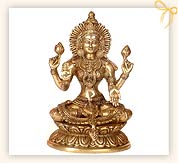 Lakshmi is regarded as the Goddess of
wealth and good fortune in Hinduism. She is the consort of
Lord Vishnu and is said to have taken different forms in
order to be with him in each of his incarnations. Thus when
he was the dwarf Vamana, she appeared from a lotus
and was known as Padma, or Kamala; when he was
the ax-wielding Parasurama the destroyer of the
warrior caste, she was his wife Dharani; when he was
King Rama, she was his queen Sita.
Lakshmi is regarded as the Goddess of
wealth and good fortune in Hinduism. She is the consort of
Lord Vishnu and is said to have taken different forms in
order to be with him in each of his incarnations. Thus when
he was the dwarf Vamana, she appeared from a lotus
and was known as Padma, or Kamala; when he was
the ax-wielding Parasurama the destroyer of the
warrior caste, she was his wife Dharani; when he was
King Rama, she was his queen Sita.
The idol of Goddess Lakshmi is often represented as seated on a lotus, sometimes being anointed by a pair of elephants. White owl is the vehicle of Goddess Lakshmi. The Goddess is worshiped by all Hindu for wealth and prosperity. It is said that the Goddess blesses the worshiper with wealth, prosperity and harmony in his life.
The idol of Goddess Lakshmi is usually crafted of the following materials :- Stone
- Brass
- Ashtadhatu
- Sphatik/Crystal
- Parad/Mercury
- Wood
The idol of Lakshmi comes in various styles and combinations. The most common ones are :
Sri Lakshmi Narayana Idol
Lord Narayana, also known as Lord Vishnu, is regarded as a major god in Hinduism and Indian mythology. Lord Vishnu represents himself as Narayana because he has goddess Lakshmi within him. Lord Vishnu's consort is Goddess Lakshmi, the Goddess of wealth. The Lakshmi Narayan idol is worshipped in Hinduism for peace, prosperity and to get the blessings of Lord Lakshmi Narayana.
Ganesha and Lakshmi Idol
The most important feature of Diwali celebrations is the Lakshmi - Ganesha pooja. Goddess Lakshmi is the Goddess of wealth and prosperity. Lord Ganesha is worshipped first on every pooja and is the God of pure consciousness, good luck, knowledge and wisdom. The auspicious pair of Lakshmi-Ganesh idol brings charm and grace to an individual's office and home.Goddess Maricihi
Marici is the goddess of Dawn or Sun's ray. The shining goddess is a Buddhist astral goddess. She is considered to be an avtaar of Vairocana, also his Shakti, as well identified as a bodhisattva, or buddha-designate. She was the mother of Sakyamuni (a form of the Buddha).
Sun god in Hindu mythology is considered an equivalent of Goddess Marichi. She is often depicted in a three-headed form, as the Shakti of Hayagriva, beautifully seated on a lotus. Her left head resembles a pig, while she rides in a chariot drawn by seven boars. The complexion is red, yellow, or white, and she is flanked by an arrow, fly whisk, horse's head in the hair, needle, prayer wheel, staff, sword, thread and trident; also in three-eyed. Her path crosses the route of the sun while traveling, thus, becoming invisible. She oversees thirty-six celestial deities and seventy-two earthly deities. All these one hundred and eight deities are responsible for showering blessings and punishing people depending on the karmas from these people's previous lives and their current lives.
Marici designates a demiurge, a product of the creator god Brahma as per the Hindu mythology.Goddess Maya
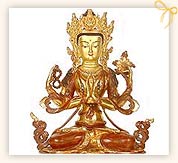 Maya is considered to be the mother of
Buddha, known popularly in the Hindu scriptures as Mahamaya,
meaning Great Maya, or Mayadevi, the Goddess Maya. While she
is known as Gutrulma in Tibetan & Queen Maya in English.
Maya is considered to be the mother of
Buddha, known popularly in the Hindu scriptures as Mahamaya,
meaning Great Maya, or Mayadevi, the Goddess Maya. While she
is known as Gutrulma in Tibetan & Queen Maya in English.
Maya means Illusion of an interplay of Substance and Energy that gives a feeling that there is something "there". Thus, Mahamaya actually means The Grandest Deception. Along with Shakti & Prakriti, Maya makes the powerful combination of the three "personified" as great goddesses. Life is unimaginable without them. Still, the humans rely heavily upon Maya as she helps them to be perceptible, & thus, access the reality.
As per the Hindu tradition, the goddess is considered the maiden-aspect of Kali. So, she is the Mahakali, who symbolizes the giver of perception.Goddess Parvati
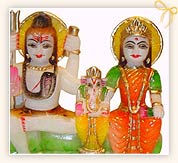 Uma, Lalitha, Gowri, Shivakamini, Aparna
Parvati is a Hindu goddess who is the wife of Lord Shiva and
the divine mother of Lord Ganesh and Lord Murugan as per the
hindu mythology. She is also believed to be the divine
sister of Lord Vishnu. According to the Shakthi philosophy,
she is the divine, the supreme Lord. She has been either
represented as Shakti or Durga, albeit the gentle aspect of
that goddess.
Uma, Lalitha, Gowri, Shivakamini, Aparna
Parvati is a Hindu goddess who is the wife of Lord Shiva and
the divine mother of Lord Ganesh and Lord Murugan as per the
hindu mythology. She is also believed to be the divine
sister of Lord Vishnu. According to the Shakthi philosophy,
she is the divine, the supreme Lord. She has been either
represented as Shakti or Durga, albeit the gentle aspect of
that goddess.
There are numerous forms of Parvati which include Uma, Lalitha, Gowri, Shivakamini, Aparna, the maternal epithet Mataji, and many hundreds of others.
The goddess name is a Sanskrit word which means "mountain". She was the daughter of Himavan, lord of the mountains and the apsara Mena. Considered as the second spouse of Shiva, the Hindu God of destruction and rejuvenation, she is no different from Dakshayani, the former consort of Shiva. It is believed that Parvati was her reincarnated form.
Parvati is the maiden form of Kali. She is the ultimate power whose hues richness is reflected through her divine attire & her jewels. Her inevitable connection with life & death, transformation & cause & effect are all reflected through the karmic golden wheel.Goddess Prajnaparamita
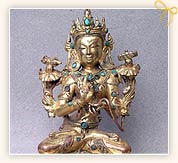 Prajnaparamita, the famous Buddhist
goddess, is the most vital of all deities. She is the
personification of the book of supreme, absolute wisdom. In
the Mahayana tradition, the goddess signifies femininity.
The text states the fundamentals of Mahayana Buddhism where
she has been described as Sarva-buddha-matri, "Mother of All
Buddhas". She is even considered as the female Buddha. While
the offsprings are the surrounding Buddhas.
Prajnaparamita, the famous Buddhist
goddess, is the most vital of all deities. She is the
personification of the book of supreme, absolute wisdom. In
the Mahayana tradition, the goddess signifies femininity.
The text states the fundamentals of Mahayana Buddhism where
she has been described as Sarva-buddha-matri, "Mother of All
Buddhas". She is even considered as the female Buddha. While
the offsprings are the surrounding Buddhas.
Identified as the Prajnaparamita book and a vajra, which is a complex symbol of the Buddhist universality, the goddess is always shown sitting in a lotus position. Supposed to be the goddess of Transcendental Wisdom, she symbolizes the feminine version of the supreme Buddha.Goddess Saraswati
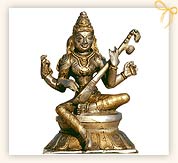 Saraswati is the Hindu Goddess of learning
and the arts. She is the daughter of Lord Shiva and Goddess
Durga. Goddess Saraswati is first referred to in literature
as the personification of the sacred river, the Saraswati,
also known as Sarasvati, and is also identified with Vac,
the goddess of speech. In later Hinduism Saraswati is
usually considered the consort of the God Brahma (the
promulgator of the Veda), but she enjoys an autonomous
position as the patroness of art, music and letters.
Saraswati is the Hindu Goddess of learning
and the arts. She is the daughter of Lord Shiva and Goddess
Durga. Goddess Saraswati is first referred to in literature
as the personification of the sacred river, the Saraswati,
also known as Sarasvati, and is also identified with Vac,
the goddess of speech. In later Hinduism Saraswati is
usually considered the consort of the God Brahma (the
promulgator of the Veda), but she enjoys an autonomous
position as the patroness of art, music and letters.
It is believed that Goddess Saraswati endows human beings with the powers of speech, wisdom and learning. The goddess has four hands representing four aspects of human personality in learning; mind, intellect, alertness and ego. The goddess has sacred scriptures in one hand, a lotus in the second hand, which is a symbol of true knowledge. With her other two hands, the goddess plays the music of love and life on a string instrument called Veena (violoin). Goddess Saraswati is dressed in white, which symbolizes purity and rides on a white swan that symbolises Sattwa Guna (purity) and discrimination.
Goddess Saraswati is annually worshiped with great enthusiasm by Hindu students and teachers alike at the advent of spring, when the Hindu year occurs in January-February.
The idols of Goddess Saraswati are usually crafted in the following materials :- Brass
- Wood
- Stone
The height and weight of these idols depends on the material used for making them.
Goddess Sita
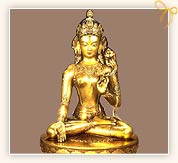 Sita, as described by the Rig Veda, was the
wife of Rama who was the seventh avatara of Vishnu. She is
considered to be the avtaar of Lakshmi on Earth. The goddess
is the main protagonist of the epic "Ramayana". The goddess
had the appellations of Bhumija, Dharanisuta, and Parthivi,
all connoting 'daughter of the earth'. Sita was the daughter
of Bhumidevi & adopted by Janaka, the king of Mithila.
Accordingl, she is known by many names. Such as Janaki,
Mythili or Maithili, Ramaa & Vaidehi.
Sita, as described by the Rig Veda, was the
wife of Rama who was the seventh avatara of Vishnu. She is
considered to be the avtaar of Lakshmi on Earth. The goddess
is the main protagonist of the epic "Ramayana". The goddess
had the appellations of Bhumija, Dharanisuta, and Parthivi,
all connoting 'daughter of the earth'. Sita was the daughter
of Bhumidevi & adopted by Janaka, the king of Mithila.
Accordingl, she is known by many names. Such as Janaki,
Mythili or Maithili, Ramaa & Vaidehi.
As per the mythological concept, Sita was discovered in a furrow in a ploughed field by King Janaka. She later got married to Rama, the prince of Ayodhya.
Sita strongly emphasizes the feminine power & that was pretty evident through her every action, reaction in her long and arduous life. She is seen as a symbol of power by every female.Manasa Devi
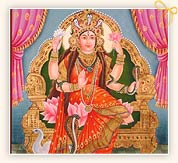 Manasa is the goddess of naga and
fertility. She fulfills the wishes & protects one against
snakebite. Associated with the earth and higher knowledge,
she is worshiped mostly in eastern India. Goddess Manasa was
the daughter of sage Kasyapa and Kadru, the sister of the
serpent-king Sesha. She has the power as well to cure
infectious diseases & shower one with wealth and prosperity.
She is ritually worshiped with sacrifices offered to her
during rainy season, since, the snakes are most active in
this season. Sometimes, she is supposed to be a pre-Aryan
goddess.
Manasa is the goddess of naga and
fertility. She fulfills the wishes & protects one against
snakebite. Associated with the earth and higher knowledge,
she is worshiped mostly in eastern India. Goddess Manasa was
the daughter of sage Kasyapa and Kadru, the sister of the
serpent-king Sesha. She has the power as well to cure
infectious diseases & shower one with wealth and prosperity.
She is ritually worshiped with sacrifices offered to her
during rainy season, since, the snakes are most active in
this season. Sometimes, she is supposed to be a pre-Aryan
goddess.
Legend has that Manasa even requested her father, Lord Shiva, to include her in the pantheon, so that she is worshipped by humans. Shiva responded to it that if Chand (of Anga kingdom) agrees to worship her, then her wish would be fulfilled. After a lot of tedious trial, Chand finally agreed to worship her with his left hand. And, thus, Manasa is the only Hindu goddess who till date is worshiped by the left hand.
Manasa Devi's well known temples can be found in Haridwar and Chandigarh.Samshana Kali
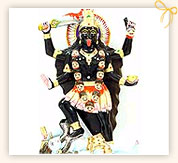 Samshana Kali is the mother who dwells
there with immaterial spirits. She is the fiercest & darkest
form of Kali. She is known for her unrestrained, wilderness
& terrifying characteristics. Her frightening look has the
capacity to give heartaches even to the most strongest of
men.
Samshana Kali is the mother who dwells
there with immaterial spirits. She is the fiercest & darkest
form of Kali. She is known for her unrestrained, wilderness
& terrifying characteristics. Her frightening look has the
capacity to give heartaches even to the most strongest of
men.
Usually, the 'Kali of the Cremation Grounds' is depicted in deep blue color where the goddess is shown with one face, three eyes, and four arms. Metaphorically, her strikingly midnight blue complexion signifies her immutable & indestructible nature. Her nature is such that she is beyond all concepts & qualities. She has the same characteristics of goddess Kali. The 'warrior' nature can never be separated from her person.
The goddess worshiped as the 'Goddess of the Dead'. She is popularly served by dakinis. She is seen as the female acolytes whose role is to arrange the funerals.Shakti Devi
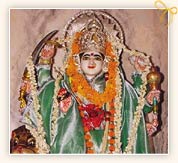 Shakti means force, power or energy in
Hinduism & she personifies the female aspect of God. She is
even referred as 'The Divine Mother'. The goddess symbolizes
the active, dynamic principles of feminine power. As per
Shaktism, she is as the Supreme Being. There is a counter
view as well in other Hindu traditions where she has been
depicted embodying the active energy and power of male
deities such as Vishnu in Vaishnavism or Shiva in Shaivism.
As we all know that Vishnu's shakti counterpart is Lakshmi,
with Parvati being the female shakti of Shiva.
Shakti means force, power or energy in
Hinduism & she personifies the female aspect of God. She is
even referred as 'The Divine Mother'. The goddess symbolizes
the active, dynamic principles of feminine power. As per
Shaktism, she is as the Supreme Being. There is a counter
view as well in other Hindu traditions where she has been
depicted embodying the active energy and power of male
deities such as Vishnu in Vaishnavism or Shiva in Shaivism.
As we all know that Vishnu's shakti counterpart is Lakshmi,
with Parvati being the female shakti of Shiva.
Shakti denotes the eternal and Supreme Power who manifests energy, and substance of everything, and all-pervading. She is connected with & identical to the power of the gods. She, like other goddesses, is the source of the universe. She even represents the violent aspects of Durgha & Kali as well the creative aspects of Shiva.
According to Tantrism philosophy, the Shakti defines the unity of opposites.Tara Devi
 Goddess Tara or Arya Tara, is a female
Bodhisattva associated with Tibetan Buddhism. Considered as
the "mother of liberation", she represents the virtues of
success in work and achievements. She is seen as Mahatara,
Great Tara, who is the supreme creator and mother of all the
Buddhas and Bodhisattvas.
Goddess Tara or Arya Tara, is a female
Bodhisattva associated with Tibetan Buddhism. Considered as
the "mother of liberation", she represents the virtues of
success in work and achievements. She is seen as Mahatara,
Great Tara, who is the supreme creator and mother of all the
Buddhas and Bodhisattvas.
As per the Hindu Mythology, Tara is the Feminine Goddess Archetype who governs the Underworld, the Earth and the Heavens, birth, death and regeneration, love and war, the seasons, all that lives and grows, the Moon cycles - Luna - feminine - creation. She is a gorgeous looking deity whose favorite animals are the sow, mare, owl and raven. Considered as one of the most popular figure in the Tibetan pantheon of deities, the name connotes 'Star'. She is one of the eight major aspects of the Divine Feminine Principle according to the Hindu scriptures. She is seen as a benevolent goddess. She is common in Buddhism, Jainism, and particularly, Tibetan Lamaism as well. She manifests asceticism, mysticism, & a protector of humanity.
Tara is known by names like Green Tara, White Tara, Red Tara, Black Tara, Yellow Tara, Blue Tara & Cittamani Tara.Uma Devi
Uma, is considered as the goddess of 'light' or the Lady of the Mountains. She is an ancient Mountain-goddess who imparts the vital virtue of balance to humanity. She has always been depicted as a beauty with benign power. Often she is known by Parvati, Ambika, Annapurna, Bhairavi, Candi, Gauri, Durga, Jagadmatai, Kali, Kanyakumari, Kumari, Mahadevi & Syama or Shiva's consort. She is seen as a divinity in her own right.
The goddess is the ferocious form of Durga according to the Hindu scriptures. She has been given the tag of a mediator as she would always resolve the conflicts of heaven. The daughter of Himavat, the God of the Great Himalayan Mountains and the heavenly nymph Mena, she is also the sister of the sacred river Ganga.
Bengal is mainly considered as the center of goddess Uma's cult.
